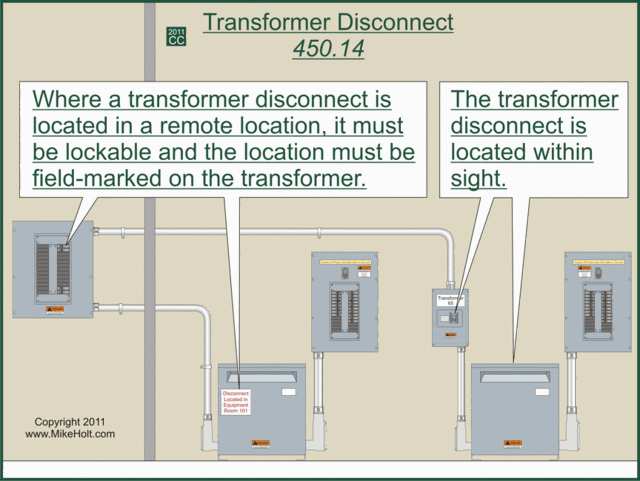I read it...Did You?
9-175 Log #659 NEC-P09 Final Action: Accept in Principle in Part
(450.14)
_______________________________________________________________
Submitter: Harold F. Willman, Colorado Code Consulting
Recommendation: Add new text to read as follows:
450.14 Transformer disconnecting means. Transformers shall have a
disconnecting means located within sight of the transformer.
Substantiation: In larger commercial buildings and multistory buildings, many
transformers have the overcurrent protection and the disconnecting means for
the transformer at the main distribution center. This main distribution center is
normally located on the bottom floor of the multistory building or in an
electrical room of a large commercial building. Transformers are scattered
throughout the building without signage on the transformer indicating the
location of disconnecting means for the transformer. By installing a
disconnecting means within sight of the transformer, maintenance and
modification of the primary and/or secondary side of the transformer would be
safer for the electricians working on the transformer. The lock out-tag out
method is not always available in the main distribution center.
Panel Meeting Action: Accept in Principle in Part
CMP-9 accepts in principle the concept of a disconnect provision for
transformers. CMP-9 rejects the requirement that this disconnecting means
must be located within sight of the transformer.
Panel Statement: See the action on Proposal 9-176 for the final requirement
that addresses the concept in this proposal that is being accepted.
Number Eligible to Vote: 12
Ballot Results: Affirmative: 12
_______________________________________________________________
9-176 Log #3821 NEC-P09 Final Action: Accept in Principle
(450.14)
_______________________________________________________________
Submitter: James J. Rogers, Bay State Inspectional Agency
Recommendation: Add new text to read as follows:
450.14 Disconnecting Means. Transformers other than listed class 2 or class
3 transformers shall have a disconnecting means located either in sight of the
transformer or remotely provided the remote disconnect is capable of being
locked in the off position. When the disconnecting means is located remote
from the transformer the locking means required shall remain in place whether
or not the locking means is installed.
Substantiation: Requiring a disconnecting means for a transformer is intended
to enhance safety for the qualified individual that is required to work on the
transformer. This is especially true in installations utilizing the requirements of
240.21(B)(3) whereby there may be several transformers in different locations
all tapped from one feeder and it may be impractical to de-energize the entire
feeder system to work on one of the transformers.
Panel Meeting Action: Accept in Principle
Revise the rule to read as follows: ?Transformers, other than Class 2 or Class
3, shall have a disconnecting means located either in sight of the transformer or
in a remote location. Where located in a remote location, the disconnecting
means shall be lockable, and the location shall be field marked on the
transformer.?
Panel Statement: CMP-9 has made editorial changes to avoid a run-on
sentence, used ?open? instead of ?off? for the disconnect position in
accordance with customary code usage, used ?where? instead of ?when?
because it is a question of place and not time, and removed the listing
limitation on the Class 2 and 3 transformers because it has no bearing on
whether a disconnecting means needs to be installed. The lockable wording
correlates with the task group results reported in Proposal 9-201.
Number Eligible to Vote: 12
Ballot Results: Affirmative: 12
Comment on Affirmative:
YOUNG, R.: The disconnecting means should be lockable in the open
position whether or not the disconnecting means is mounted either within sight
of the transformer or in a remote location.


